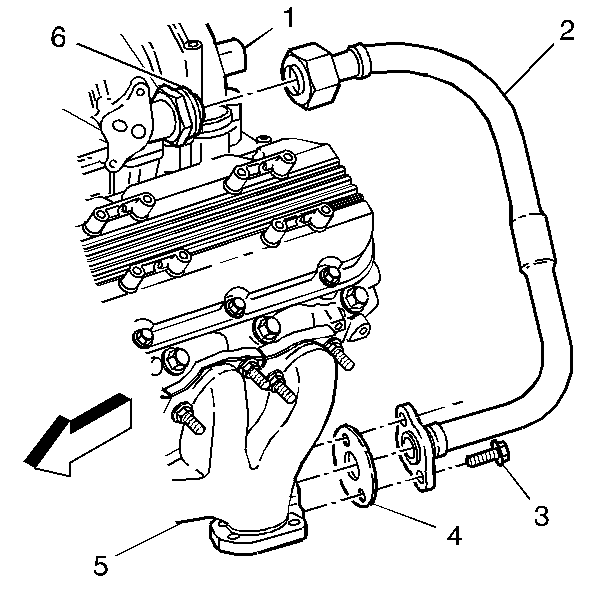Caution: Avoid breathing fumes and swallowing EGR exhaust deposits when removing
components for cleaning as bodily injury may result.
Whenever the exhaust gas recirculation (EGR) valve is
removed, or during regularly scheduled EGR system maintenance, the EGR system
should be inspected and cleaned. This will insure that the EGR system
will function properly under all operating conditions. Proper EGR system
service consists of the following five steps:
- EGR system diagnosis -- Diagnosis of the EGR system should
be performed if required by engine performance or engine driveability symptoms
and no powertrain control module (PCM) diagnostic trouble codes ( DTCs) are
set .
- EGR valve pipe cleaning and checking for leaks -- Clean and
check the EGR pipe from the exhaust manifold to the EGR valve and the EGR
pipe from the water pump crossover to the throttle body spacer.
- EGR valve cleaning -- If the EGR system is operating correctly,
the EGR valve can be removed, checked for deposits, cleaned, and replaced.
Use the procedure below for this operation.
| 3.1. | Remove the EGR valve from the engine. |
| 3.2. | While holding the EGR valve in your hand, using a pencil eraser
or other suitable soft instrument to depress the pintle several times. The
pintle should move in and out smoothly. Replace any valve that exhibits
tendencies to stick. |
| 3.3. | While holding the EGR valve base in your hand, try to rotate
the connector housing. Repeat for the coil housing. Replace any valve that
exhibits looseness. |
| | Notice: Damage to the powdered metal EGR valve base occurs if cleaned with a
wire brush, a wire wheel, solvents, sharp tools, or sand blasting.
Cleaning by these methods is not recommended.
|
| 3.4. | Inspect the EGR valve pintle and seat for deposits. |
| 3.5. | Inspect the passage in the intake manifold for deposits.
Remove all loose particles. |
| 3.6. | Replace the EGR valve on the engine using a new gasket. |
| 3.7. | Wash-up after any contact with deposits from the EGR system. |
Removal Procedure
Caution: Unless directed otherwise, the ignition and start switch must be in the OFF or LOCK position, and all electrical loads must be OFF before servicing
any electrical component. Disconnect the negative battery cable to prevent an electrical spark should a tool or equipment come in contact with an exposed electrical terminal. Failure to follow these precautions may result in personal injury and/or damage to
the vehicle or its components.
- Disconnect
the negative battery cable.

- Remove the engine cover
from the interior. Refer to
Engine Cover Replacement
in Interior Trim.
- Remove the linear EGR valve pipe flange nut (6) from the intake
manifold (1).
- Remove the linear EGR valve pipe flange bolts (3) from the exhaust
manifold (5).
- Remove the linear EGR valve pipe (2) from the vehicle.
- Clean and inspect all gasket mating surfaces to be free of oil
and foreign material.
Installation Procedure

- Install the linear EGR
valve pipe (2) to the intake manifold (6),(1). Do not tighten the flange nut
completely, leave it loose.
Notice: Use the correct fastener in the correct location. Replacement fasteners
must be the correct part number for that application. Fasteners requiring
replacement or fasteners requiring the use of thread locking compound or sealant
are identified in the service procedure. Do not use paints, lubricants, or
corrosion inhibitors on fasteners or fastener joint surfaces unless specified.
These coatings affect fastener torque and joint clamping force and may damage
the fastener. Use the correct tightening sequence and specifications when
installing fasteners in order to avoid damage to parts and systems.
Important: Make sure that both mating surfaces are aligned properly, before performing
tightening procedure.
- Install the linear EGR valve pipe (2) and new gasket (4) to the exhaust
manifold (5). Do not tighten the flange bolts (3) completely, leave them loose.
Tighten
Tighten the linear EGR valve pipe flange nut (6) to the intake manifold
(1) to 60 N·m (44 lb ft).
Tighten
Tighten the linear EGR valve pipe flange bolts (3) to the exhaust manifold
(5) to 26 N·m (19 lb ft).
- Connect the negative battery cable.
- Start the engine and check for exhaust leaks.
- Install the engine cover.


